实验6:开源控制器实践——RYU
一.基本要求
1.搭建下图所示SDN拓扑,协议使用Open Flow 1.0,并连接Ryu控制器,通过Ryu的图形界面查看网络拓扑。
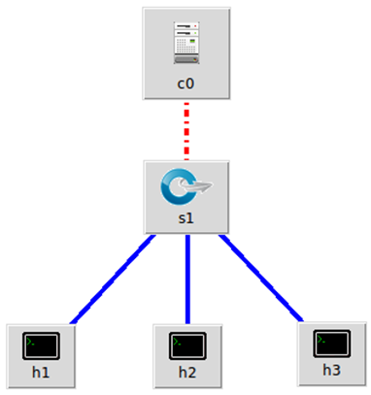
搭建拓扑链接Ryu控制器通过图形界面查看如图:
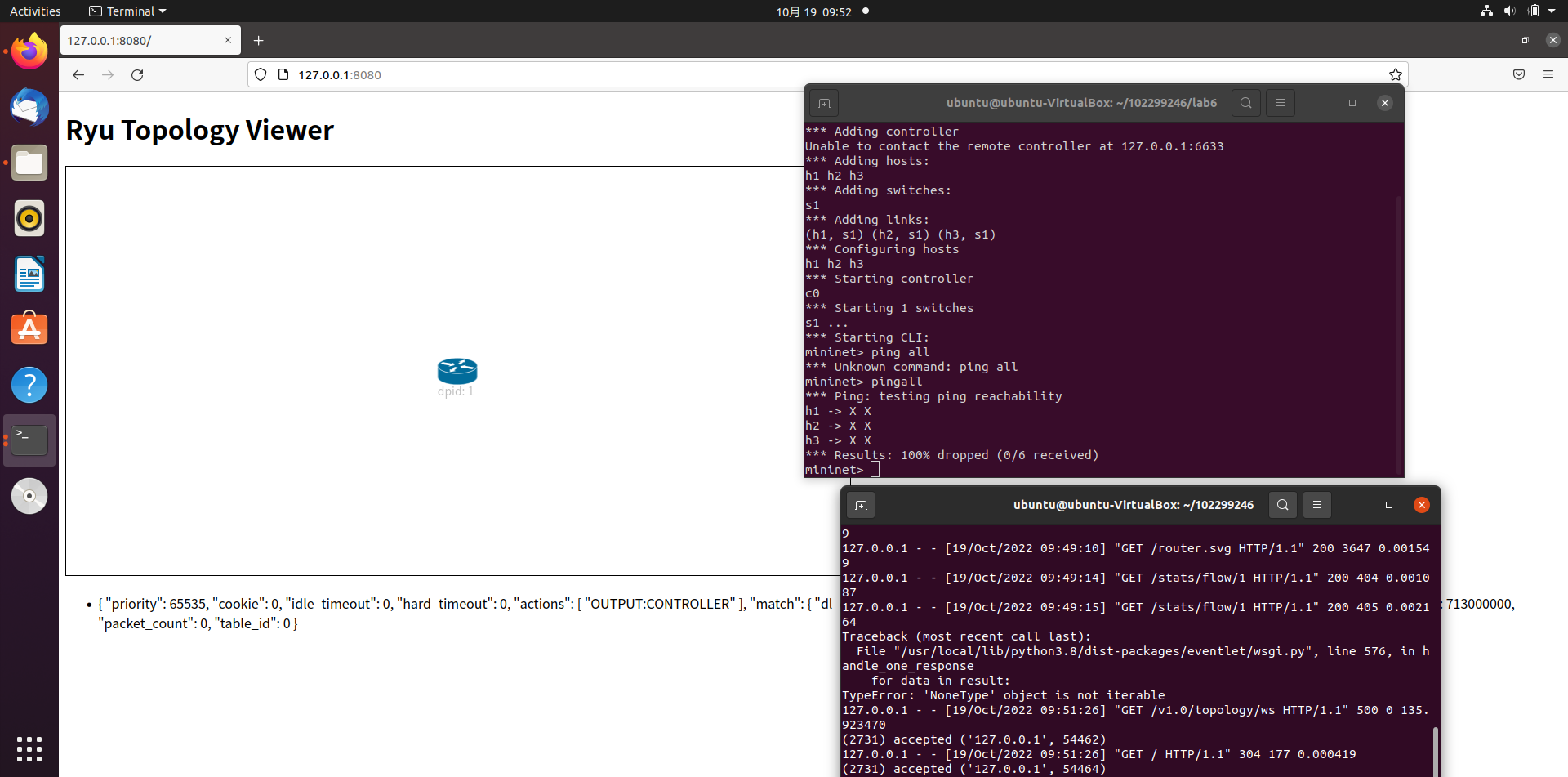
2.阅读Ryu文档的The First Application一节,运行当中的L2Switch,h1 ping h2或h3,在目标主机使用 tcpdump 验证L2Switch,分析L2Switch和POX的Hub模块有何不同。
L2Switch.py代码如下:
点击查看代码
from ryu.base import app_manager
from ryu.controller import ofp_event
from ryu.controller.handler import MAIN_DISPATCHER
from ryu.controller.handler import set_ev_cls
from ryu.ofproto import ofproto_v1_0
class L2Switch(app_manager.RyuApp):
OFP_VERSIONS = [ofproto_v1_0.OFP_VERSION]
def __init__(self, *args, **kwargs):
super(L2Switch, self).__init__(*args, **kwargs)
@set_ev_cls(ofp_event.EventOFPPacketIn, MAIN_DISPATCHER)
def packet_in_handler(self, ev):
msg = ev.msg
dp = msg.datapath
ofp = dp.ofproto
ofp_parser = dp.ofproto_parser
actions = [ofp_parser.OFPActionOutput(ofp.OFPP_FLOOD)]
data = None
if msg.buffer_id == ofp.OFP_NO_BUFFER:
data = msg.data
out = ofp_parser.OFPPacketOut(
datapath=dp, buffer_id=msg.buffer_id, in_port=msg.in_port,
actions=actions, data = data)
dp.send_msg(out)
运行并验证L2Switch
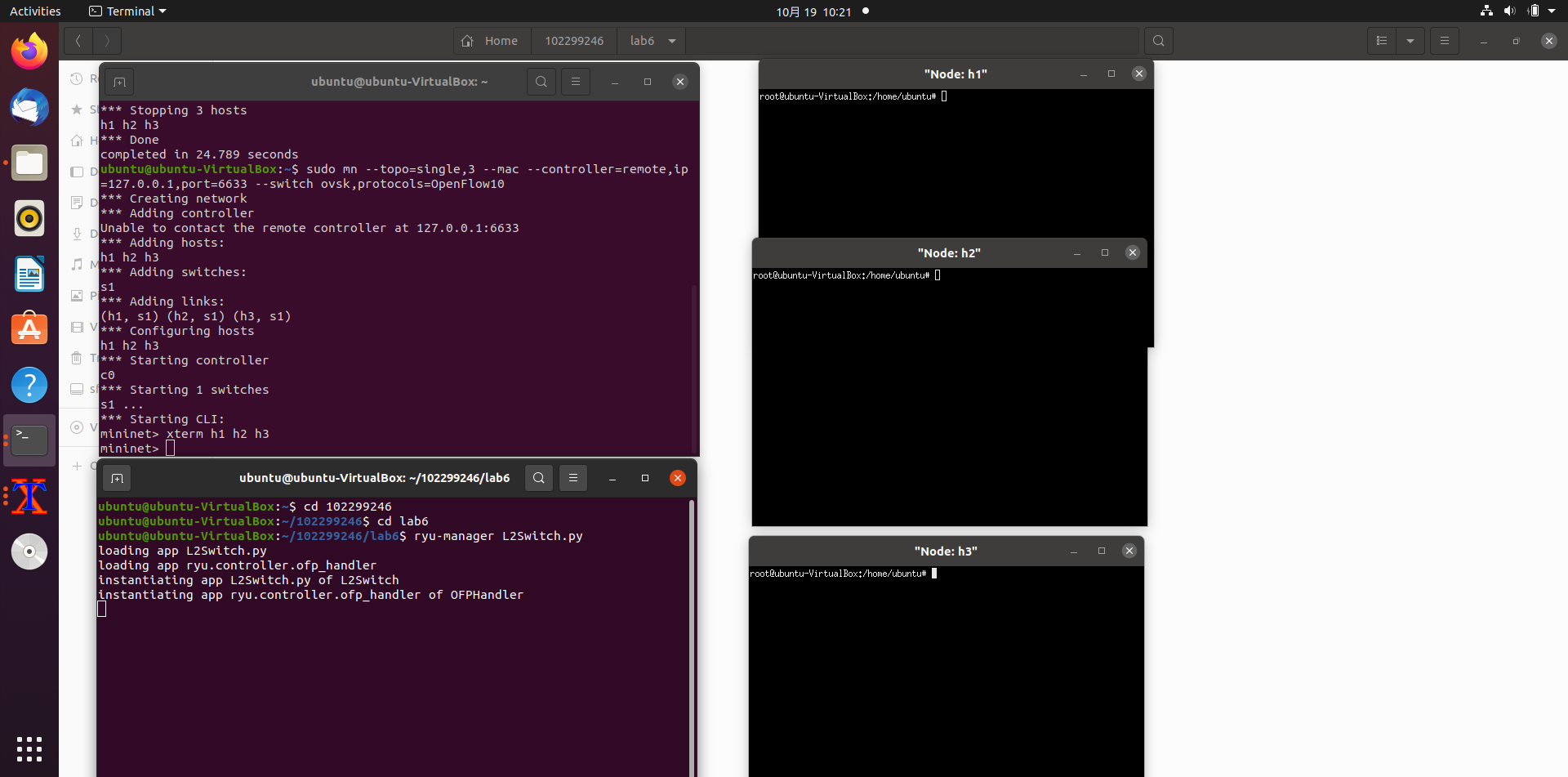
h1 ping h2
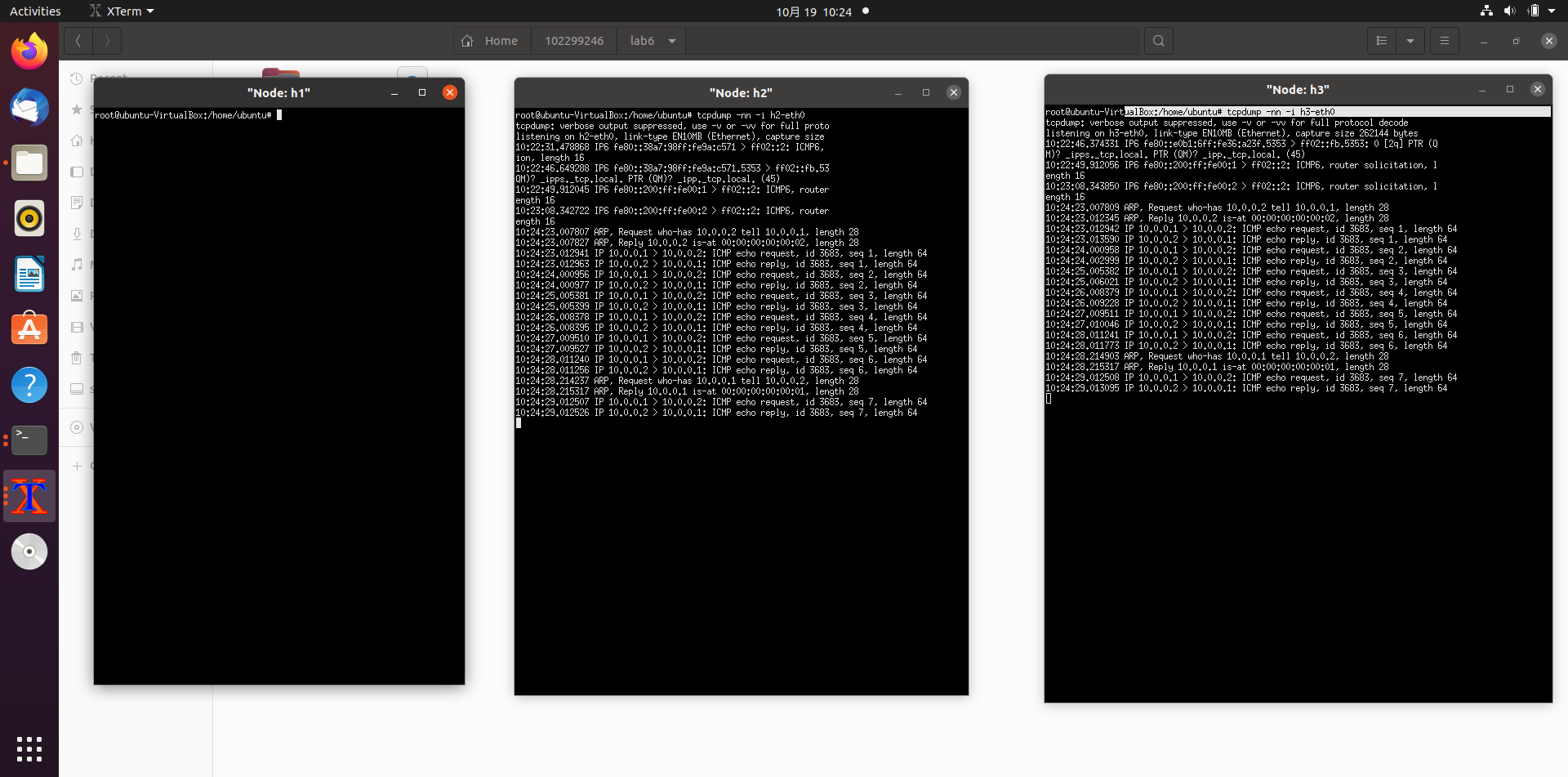
h1 ping h3

分析L2Switch和POX的Hub模块有何不同:
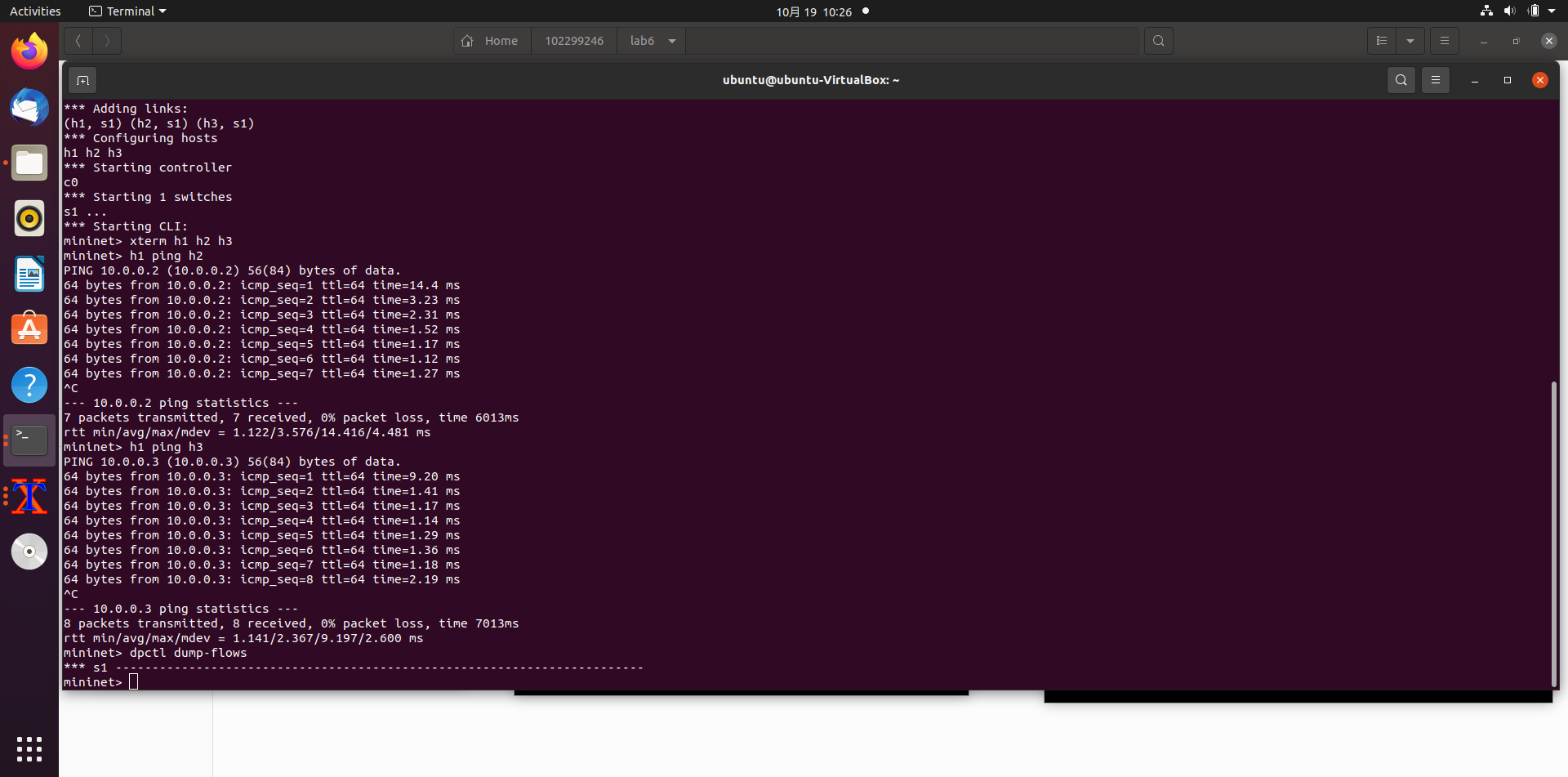
通过dpctl dump-flows指令发现无法查看流表项
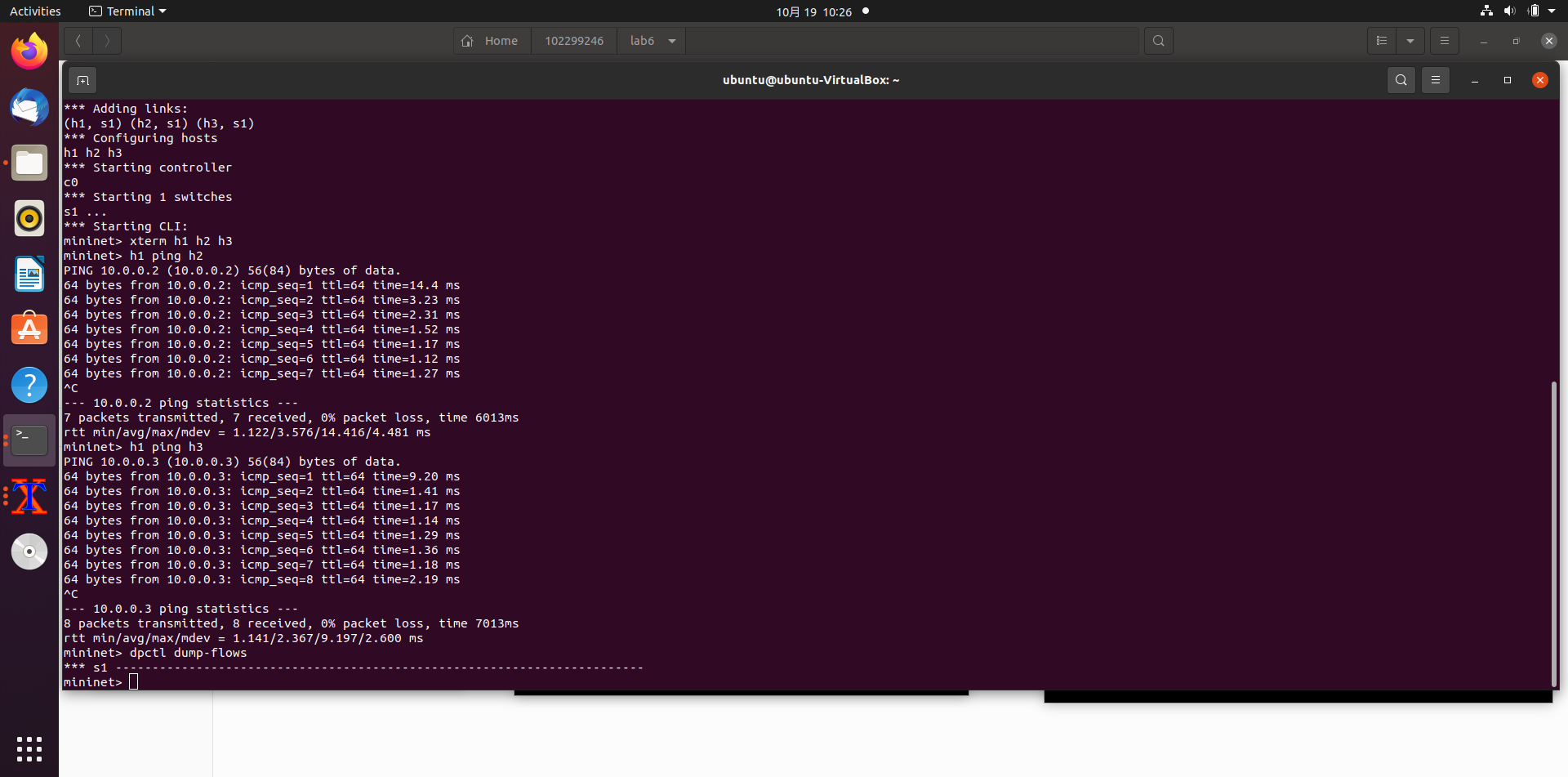
而使用pox的hub模块则会看到流表,如下图

3.编程修改L2Switch.py,另存为L2xxxxxxxxx.py,使之和POX的Hub模块的变得一致
代码如下:
点击查看代码
from ryu.base import app_manager
from ryu.ofproto import ofproto_v1_3
from ryu.controller import ofp_event
from ryu.controller.handler import MAIN_DISPATCHER, CONFIG_DISPATCHER
from ryu.controller.handler import set_ev_cls
class hub(app_manager.RyuApp):
OFP_VERSIONS = [ofproto_v1_3.OFP_VERSION]
def __init__(self, *args, **kwargs):
super(hub, self).__init__(*args, **kwargs)
@set_ev_cls(ofp_event.EventOFPSwitchFeatures, CONFIG_DISPATCHER)
def switch_feathers_handler(self, ev):
datapath = ev.msg.datapath
ofproto = datapath.ofproto
ofp_parser = datapath.ofproto_parser
# install flow table-miss flow entry
match = ofp_parser.OFPMatch()
actions = [ofp_parser.OFPActionOutput(ofproto.OFPP_CONTROLLER, ofproto.OFPCML_NO_BUFFER)]
# 1\OUTPUT PORT, 2\BUFF IN SWITCH?
self.add_flow(datapath, 0, match, actions)
def add_flow(self, datapath, priority, match, actions):
# 1\ datapath for the switch, 2\priority for flow entry, 3\match field, 4\action for packet
ofproto = datapath.ofproto
ofp_parser = datapath.ofproto_parser
# install flow
inst = [ofp_parser.OFPInstructionActions(ofproto.OFPIT_APPLY_ACTIONS, actions)]
mod = ofp_parser.OFPFlowMod(datapath=datapath, priority=priority, match=match, instructions=inst)
datapath.send_msg(mod)
@set_ev_cls(ofp_event.EventOFPPacketIn, MAIN_DISPATCHER)
def packet_in_handler(self, ev):
msg = ev.msg
datapath = msg.datapath
ofproto = datapath.ofproto
ofp_parser = datapath.ofproto_parser
in_port = msg.match['in_port'] # get in port of the packet
# add a flow entry for the packet
match = ofp_parser.OFPMatch()
actions = [ofp_parser.OFPActionOutput(ofproto.OFPP_FLOOD)]
self.add_flow(datapath, 1, match, actions)
# to output the current packet. for install rules only output later packets
out = ofp_parser.OFPPacketOut(datapath=datapath, buffer_id=msg.buffer_id, in_port=in_port, actions=actions)
# buffer id: locate the buffered packet
datapath.send_msg(out)
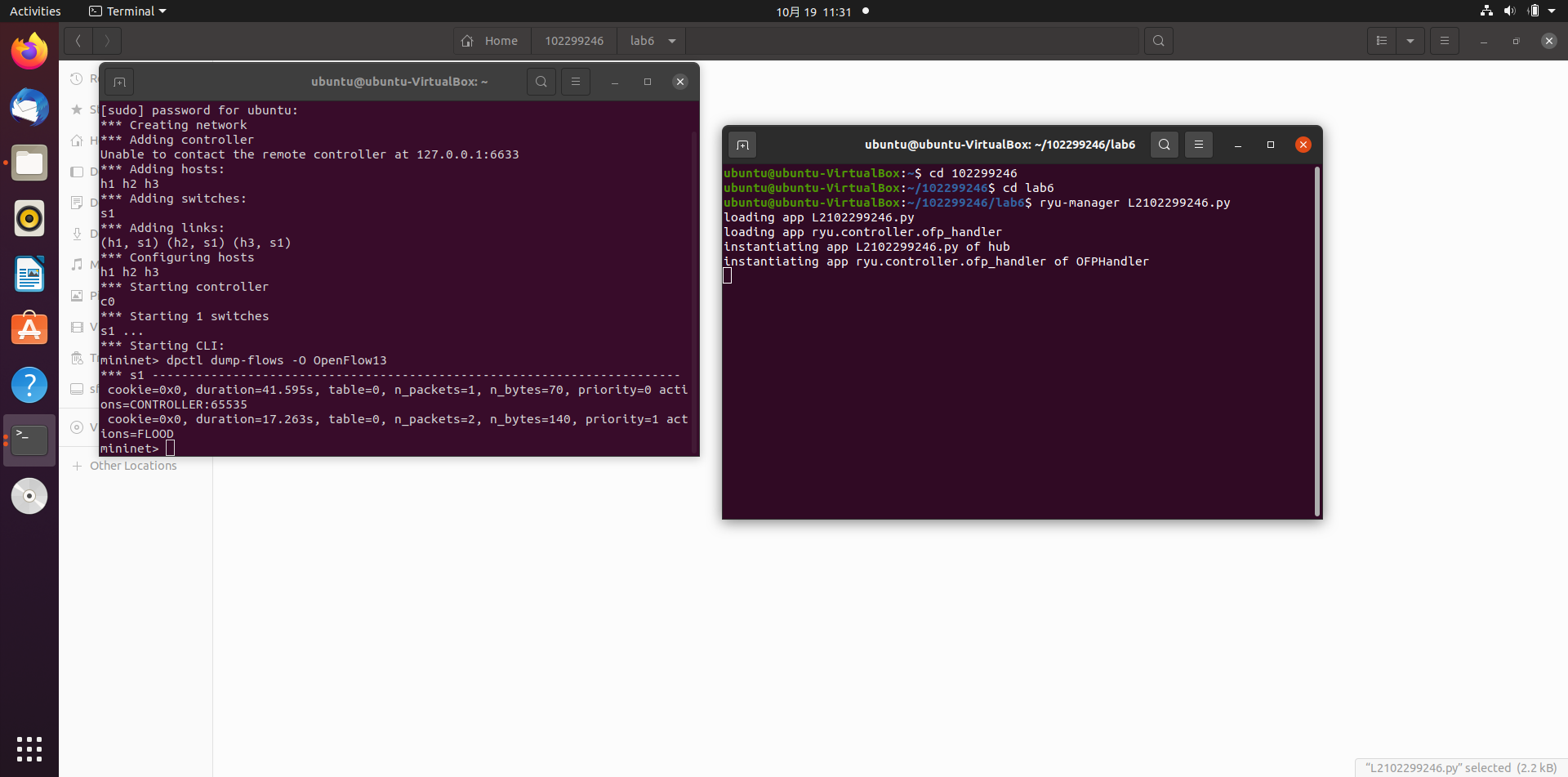
二.进阶要求
1.阅读Ryu关于simple_switch.py和simple_switch_1x.py的实现,以simple_switch_13.py为例,完成其代码的注释工作,并回答下列问题:
代码注释如下:
点击查看代码
# Copyright (C) 2011 Nippon Telegraph and Telephone Corporation.
#
# Licensed under the Apache License, Version 2.0 (the "License");
# you may not use this file except in compliance with the License.
# You may obtain a copy of the License at
#
# http://www.apache.org/licenses/LICENSE-2.0
#
# Unless required by applicable law or agreed to in writing, software
# distributed under the License is distributed on an "AS IS" BASIS,
# WITHOUT WARRANTIES OR CONDITIONS OF ANY KIND, either express or
# implied.
# See the License for the specific language governing permissions and
# limitations under the License.
from ryu.base import app_manager #app的基类
from ryu.controller import ofp_event #OpenFlow的事件
from ryu.controller.handler import CONFIG_DISPATCHER, MAIN_DISPATCHER
from ryu.controller.handler import set_ev_cls
from ryu.ofproto import ofproto_v1_3#应用的是OpenFlow1.3协议
from ryu.lib.packet import packet
from ryu.lib.packet import ethernet #引入了基本的网络协议
from ryu.lib.packet import ether_types
class SimpleSwitch13(app_manager.RyuApp):
OFP_VERSIONS = [ofproto_v1_3.OFP_VERSION] #应用的版本是OpenFlow1.3
def __init__(self, *args, **kwargs):
super(SimpleSwitch13, self).__init__(*args, **kwargs)
self.mac_to_port = {} #MAC-端口对
@set_ev_cls(ofp_event.EventOFPSwitchFeatures, CONFIG_DISPATCHER)
#起到了事件响应的功能
#当接收到feature-reply报文后执行下面的函数下发table-miss表项
def switch_features_handler(self, ev):
datapath = ev.msg.datapath #获取数据通路即交换机
ofproto = datapath.ofproto #获取数据通路的协议
parser = datapath.ofproto_parser #对协议进行解析
# install table-miss flow entry
#
# We specify NO BUFFER to max_len of the output action due to
# OVS bug. At this moment, if we specify a lesser number, e.g.,
# 128, OVS will send Packet-In with invalid buffer_id and
# truncated packet data. In that case, we cannot output packets
# correctly. The bug has been fixed in OVS v2.1.0.
match = parser.OFPMatch() #全匹配
actions = [parser.OFPActionOutput(ofproto.OFPP_CONTROLLER,
ofproto.OFPCML_NO_BUFFER)]
#设置table-miss表项的动作:将数据包发至控制器
self.add_flow(datapath, 0, match, actions)
#将0优先级、全匹配、动作为“将数据包发至控制器”的table-miss表项下发给交换机。
#这样以后交换机不知道咋处理的数据包会自动发至控制器。
def add_flow(self, datapath, priority, match, actions, buffer_id=None):
#下发流表项
ofproto = datapath.ofproto
parser = datapath.ofproto_parser
inst = [parser.OFPInstructionActions(ofproto.OFPIT_APPLY_ACTIONS,
actions)]
if buffer_id:
mod = parser.OFPFlowMod(datapath=datapath, buffer_id=buffer_id,
priority=priority, match=match,
instructions=inst)
else:
mod = parser.OFPFlowMod(datapath=datapath, priority=priority,
match=match, instructions=inst)
datapath.send_msg(mod)
@set_ev_cls(ofp_event.EventOFPPacketIn, MAIN_DISPATCHER)
#在MAIN_DISPATCHER阶段碰到EventOFPPacketIn事件的时候执行下面的函数。
#即控制器收到数据包的时候执行下面的函数。
#控制器什么时候会收到数据包呢:就是交换机现有的流表项无法与数据包匹配,利用table-miss表项交给控制器处理。
def _packet_in_handler(self, ev):
# If you hit this you might want to increase
# the "miss_send_length" of your switch
if ev.msg.msg_len < ev.msg.total_len:
self.logger.debug("packet truncated: only %s of %s bytes",
ev.msg.msg_len, ev.msg.total_len)
msg = ev.msg
datapath = msg.datapath
ofproto = datapath.ofproto
parser = datapath.ofproto_parser
in_port = msg.match['in_port']
#此时能进入这里的都是不知道该被咋处理的数据包。
#记录下数据包从哪个端口进来
#提取数据包的信息
pkt = packet.Packet(msg.data)
eth = pkt.get_protocols(ethernet.ethernet)[0]
if eth.ethertype == ether_types.ETH_TYPE_LLDP:
# ignore lldp packet
return
dst = eth.dst #获取数据包的目的MAC地址
src = eth.src #获取数据包的源MAC地址
dpid = format(datapath.id, "d").zfill(16)
self.mac_to_port.setdefault(dpid, {})
self.logger.info("packet in %s %s %s %s", dpid, src, dst, in_port)
# learn a mac address to avoid FLOOD next time.
#设置该交换机的MAC-端口对。
#即将数据包的源MAC地址与进入的端口相对应,完成了学习。
self.mac_to_port[dpid][src] = in_port
#如果知道目的MAC地址与哪个出的端口相对应,那么就直接转发。
#否则需要泛洪寻找出的端口。
if dst in self.mac_to_port[dpid]:
out_port = self.mac_to_port[dpid][dst]
else:
out_port = ofproto.OFPP_FLOOD
#给流表项赋予动作:遇到该目的MAC地址的时候从这个端口转发。
actions = [parser.OFPActionOutput(out_port)]
# install a flow to avoid packet_in next time
if out_port != ofproto.OFPP_FLOOD:
#创建匹配域:以后再遇到这种情况就知道从哪个端口转发了。
match = parser.OFPMatch(in_port=in_port, eth_dst=dst, eth_src=src)
# verify if we have a valid buffer_id, if yes avoid to send both
# flow_mod & packet_out
if msg.buffer_id != ofproto.OFP_NO_BUFFER:
self.add_flow(datapath, 1, match, actions, msg.buffer_id)
return
else:
self.add_flow(datapath, 1, match, actions)
data = None
if msg.buffer_id == ofproto.OFP_NO_BUFFER:
data = msg.data
#下发流表项
out = parser.OFPPacketOut(datapath=datapath, buffer_id=msg.buffer_id,
in_port=in_port, actions=actions, data=data)
datapath.send_msg(out)
回答问题:
1.代码当中的mac_to_port的作用是什么?
mac_to_port的作用是保存mac地址到交换机端口的映射
2.simple_switch和simple_switch_13在dpid的输出上有何不同?
在simple_switch_13.py中为dpid = format(datapath.id, "d").zfill(16)
在simple_switch.py中为dpid = datapath.id
在simple_switch_13.py中使用了zfill() 方法返回指定长度为16的字符串,原字符串右对齐,前面填充0;而simple_switch.py直接输出dpid
3.相比simple_switch,simple_switch_13增加的switch_feature_handler实现了什么功能?
增加了实现交换机以特性应答消息响应特性请求功能
4.simple_switch_13是如何实现流规则下发的?
在触发PacketIn事件后,首先解析相关数据结构,获取协议信息、获取源端口、包学习,交换机信息,以太网信息,等。如果以太网类型是LLDP类型,则忽略。如果不是LLDP类型,则获取目的端口和源端口还有交换机id,然后进行交换机自学习,先学习源地址对应的交换机的入端口,再查看是否已经学习目的mac地址,如果没有就洪泛转发。如果学习过,则查看是否有buffer_id,如果有则在添加流时加上buffer_id,向交换机发送数据包和流表。
5.switch_features_handler和_packet_in_handler两个事件在发送流规则的优先级上有何不同?
switch_features_handler下发流表的优先级比_packet_in_handler高
2.编程实现和ODL实验的一样的硬超时功能。
编写Python脚本 hardtimeout代码如下:
点击查看代码
# Copyright (C) 2011 Nippon Telegraph and Telephone Corporation.
#
# Licensed under the Apache License, Version 2.0 (the "License");
# you may not use this file except in compliance with the License.
# You may obtain a copy of the License at
#
# http://www.apache.org/licenses/LICENSE-2.0
#
# Unless required by applicable law or agreed to in writing, software
# distributed under the License is distributed on an "AS IS" BASIS,
# WITHOUT WARRANTIES OR CONDITIONS OF ANY KIND, either express or
# implied.
# See the License for the specific language governing permissions and
# limitations under the License.
from ryu.base import app_manager
from ryu.controller import ofp_event
from ryu.controller.handler import CONFIG_DISPATCHER, MAIN_DISPATCHER
from ryu.controller.handler import set_ev_cls
from ryu.ofproto import ofproto_v1_3
from ryu.lib.packet import packet
from ryu.lib.packet import ethernet
from ryu.lib.packet import ether_types
class SimpleSwitch13(app_manager.RyuApp):
OFP_VERSIONS = [ofproto_v1_3.OFP_VERSION]
def __init__(self, *args, **kwargs):
super(SimpleSwitch13, self).__init__(*args, **kwargs)
self.mac_to_port = {}
@set_ev_cls(ofp_event.EventOFPSwitchFeatures, CONFIG_DISPATCHER)
def switch_features_handler(self, ev):
datapath = ev.msg.datapath
ofproto = datapath.ofproto
parser = datapath.ofproto_parser
# install table-miss flow entry
#
# We specify NO BUFFER to max_len of the output action due to
# OVS bug. At this moment, if we specify a lesser number, e.g.,
# 128, OVS will send Packet-In with invalid buffer_id and
# truncated packet data. In that case, we cannot output packets
# correctly. The bug has been fixed in OVS v2.1.0.
match = parser.OFPMatch()
actions = [parser.OFPActionOutput(ofproto.OFPP_CONTROLLER,
ofproto.OFPCML_NO_BUFFER)]
self.add_flow(datapath, 0, match, actions)
def add_flow(self, datapath, priority, match, actions, buffer_id=None, hard_timeout=0):
ofproto = datapath.ofproto
parser = datapath.ofproto_parser
inst = [parser.OFPInstructionActions(ofproto.OFPIT_APPLY_ACTIONS,
actions)]
if buffer_id:
mod = parser.OFPFlowMod(datapath=datapath, buffer_id=buffer_id,
priority=priority, match=match,
instructions=inst, hard_timeout=hard_timeout)
else:
mod = parser.OFPFlowMod(datapath=datapath, priority=priority,
match=match, instructions=inst, hard_timeout=hard_timeout)
datapath.send_msg(mod)
@set_ev_cls(ofp_event.EventOFPPacketIn, MAIN_DISPATCHER)
def _packet_in_handler(self, ev):
# If you hit this you might want to increase
# the "miss_send_length" of your switch
if ev.msg.msg_len < ev.msg.total_len:
self.logger.debug("packet truncated: only %s of %s bytes",
ev.msg.msg_len, ev.msg.total_len)
msg = ev.msg
datapath = msg.datapath
ofproto = datapath.ofproto
parser = datapath.ofproto_parser
in_port = msg.match['in_port']
pkt = packet.Packet(msg.data)
eth = pkt.get_protocols(ethernet.ethernet)[0]
if eth.ethertype == ether_types.ETH_TYPE_LLDP:
# ignore lldp packet
return
dst = eth.dst
src = eth.src
dpid = format(datapath.id, "d").zfill(16)
self.mac_to_port.setdefault(dpid, {})
self.logger.info("packet in %s %s %s %s", dpid, src, dst, in_port)
# learn a mac address to avoid FLOOD next time.
self.mac_to_port[dpid][src] = in_port
if dst in self.mac_to_port[dpid]:
out_port = self.mac_to_port[dpid][dst]
else:
out_port = ofproto.OFPP_FLOOD
actions = [parser.OFPActionOutput(out_port)]\
actions_timeout=[]
# install a flow to avoid packet_in next time
if out_port != ofproto.OFPP_FLOOD:
match = parser.OFPMatch(in_port=in_port, eth_dst=dst, eth_src=src)
# verify if we have a valid buffer_id, if yes avoid to send both
# flow_mod & packet_out
hard_timeout=10
if msg.buffer_id != ofproto.OFP_NO_BUFFER:
self.add_flow(datapath, 2, match,actions_timeout, msg.buffer_id,hard_timeout=10)
self.add_flow(datapath, 1, match, actions, msg.buffer_id)
return
else:
self.add_flow(datapath, 2, match, actions_timeout, hard_timeout=10)
self.add_flow(datapath, 1, match, actions)
data = None
if msg.buffer_id == ofproto.OFP_NO_BUFFER:
data = msg.data
out = parser.OFPPacketOut(datapath=datapath, buffer_id=msg.buffer_id,
in_port=in_port, actions=actions, data=data)
datapath.send_msg(out)
验证结果如图:
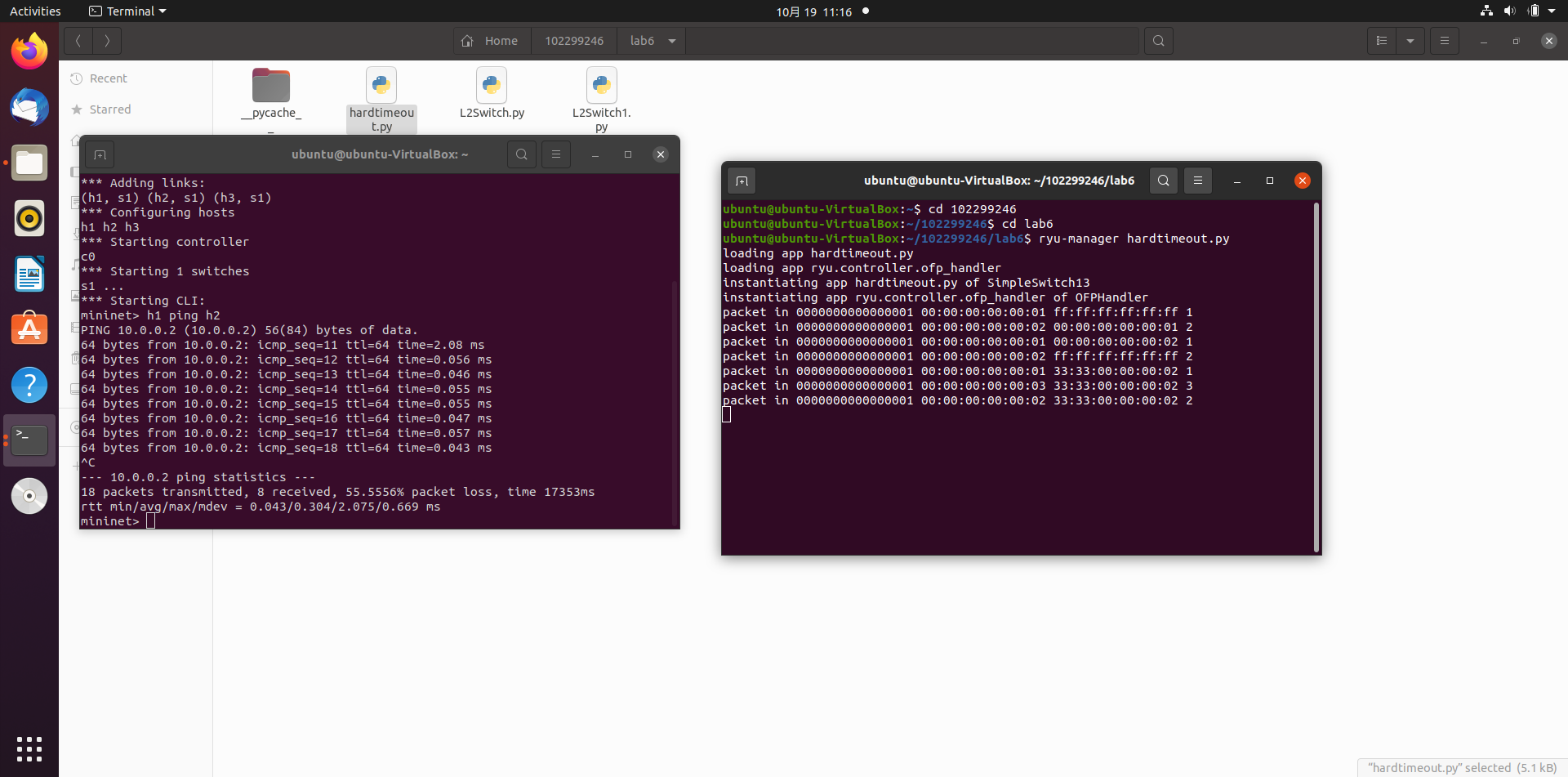
自我总结:
遇到的问题:
在进阶要求中需要进行代码注释,很多地方看不懂,于是在csdn上查询了相关的信息完成了注释。
在连接ryu控制器输入命令ryu-manager ryu/ryu/app/gui_topology/gui_topology.py --observe-links后NotFoundError,查询相关资料后发现不能在ryu目录中执行,需要在上一级文件夹中执行命令,修改后即可正常使用。
个人感想:
通过ryu的使用,明白了ryu与pox转发的流表的区别,pox是直接向交换机发送流表项的,而ryu要经过处理packet_in事件后,才向交换机下发流表
基本掌握了部署RYU控制器的方法;大致了解了RYU控制器实现软件定义的集线器原理;并且初步理解了RYU控制器实现软件定义的交换机原理。



